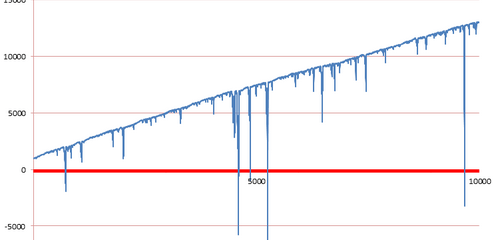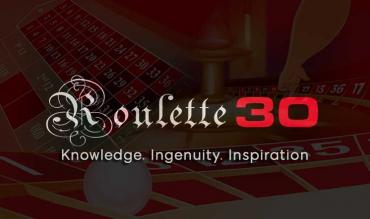The Labouchere strategy is a betting progression that has taken its name from the English aristocrat and avid roulette player Henry Labouchère (1831-1912) and probably the best known roulette system, surpassed in fame only by the Martingale. The exact same strategy is also refered to as:
Split Martingale, Cancellation System, American Cancellation, American Progression and Montante Américaine.
Don’t be confused or discouraged by the multitude of names. It is an extremely interesting and quite simple strategy for roulette. It gives good results too, except in the very rare cases of extremely bad streaks of roulette spins. You know… those days when the roulette wheel really hates your guts!
Main idea
The Split- Martingale is one of the most ingenious betting methods for roulette. It was originally created for betting the Even Chances (or Simple Chances [red, black, high, low, odd, even). The philosophy, the main idea, behind it is to be able to recoup a number of losses with a much smaller number of wins. This basic principle, is also the heart of the famous Martingale progression. Like Martingale, the Cancellation system is also a negative progression, that is, it asks you to increase your bets when you lose. However, while the Martingale tries to recoup all our losses with just one win, Labouchere, takes a more balanced approach and tries to recoup our losses not in just one spin, but in a number of spins almost equal to the half of our lost spins.
Description
Each session starts by writing down an initial betting sequence. For simplicity purposes we will describe the classic version of the cancellation system, with a 1-2-3 starting betting sequence.
- You write three numbers in sequence e.g. 1 2 3. The sum of these numbers (in this case 1 +2 +3 = 6) will be the profit when you finish this session.
- Bet the sum of the first and last number in your sequence
- When you win erase the two numbers you have bet (the first and the last in your sequence)
- When you lose, you add the sum (your bet) at the end
Example:
1,2,3
bet: 1+3=4
lose
add 4 to the end
1,2,3,4
bet: 1+4=5
lose
add the 5 to the end
1,2,3,4,5
bet: 1+5 =6
win
erase 1 and 5
2,3,4
bet: 2+4=6
lose
add 6 to the end
2,3,4,6
bet = 2+6=8
lose
add 8 to the end
2,3,4,6,8
bet: 2+8=10
win,
erase 2 and 8
3,4,6
bet: 3+6=9
lose
add 9 to the end
3,4,6,9
bet: 3+9=12
lose
add 12
3,4,6,9,12
bet: 3+12=15
win
erase 3 and 12
4,6,9
bet 4 +9 = 13
win
erase the 4 and 9
6.
bet 6.
win
End game. Start over again by writing 1,2,3
In 11 spins, with 6 losses and 5 wins, we won 6 units. Not bad at all.
Bet selection
Theoretically, your bet selection makes no difference to the success of the system. However “Follow the Last” is Kavouras’ preferred bet selection on even chances. Follow the Last means betting on the repetition of the last outcome (after red has come we bet on red etc.). With this bet selection you hope for long strings of the same outcome (Red, Red, Red etc.) and you loose when the outcomes alternate (Red-Black-Red-Black etc.)
Analysis and evaluation
With this strategy, each win compensates two losses, therefore when your won spins are just over half of your lost spins you make a profit and finish the session. To put it in another way, you just need a 1/3 win ratio to be a winner! To be exact, the American Cancellation system requires you to win 1/3 of the spins played plus two, in order to be in profit.This is quite amazing if you think about it.
Examples:
In 100 spins, you just need to win 33+2= 35 spins to be in profit
In 30 spins, you just need 10+2= 12 spins to be a winner
In 60 spins, you just need 20+2= 22 spins
The only way to lose using the Labouchere for even chances, is the losing spins to keep outnumber the winning spins by roughly 2 to 1. In this (rare) case though, your losses can be quite dramatic. They are not as dramatic as with the Martingale system, but still, quite high. Labouches is not an infallible method, and when it loses, like most negative progressions, it loses BIG time. A lost session can wipe out many won sessions.

The graph shows the bankroll fluctuation in 10.000 spins by playing the Labouchere system. One immediately notices two things: 1) the upward trend, which indicates our constant profits and 2) the HUGE sharp hits to our bankroll in those cases when everything goes wrong. Pretty telling…
Variations and modifications of the Cancellation System
The Labouchere strategy, is not only effective, but also very flexible. Once you understand the underlying principles, it invites you for modifications and it inspires you to make your own roulette strategy based on it. It is the mother of many great roulette systems. Indeed, many different versions of the split martingale have seen the light of day. Some times the differences are unimportant and sometimes they are huge, transforming the Labouchere to a totally new system. The variations of the basic strategy can be divided into four categories as follows.
Modifications of the initial bet sequence
The initial betting sequence is not written in stone. You can change it to your hearts content. This can have quite an influence on how the progression and the bet amounts develop on the course of the session.
If you start with higher numbers and/or a longer sequence, you have more profit every time you finish your session, but your sessions become more dangerous and the bets escalate faster.
Example: If your initial sequence is 3,4,5,6 you gain 18 units every time you finish an attack, instead of 6 units with the classic 1,2,3 sequence
On the other hand, if you want more safety you can start with just one number instead of a sequence of three numbers. There is even a super safe version of the Labouchere, which starts with 10 zeros (or even more!) and a 1. In this case the starting sequence looks something like this:
0,0,0,0,0,0,0,0,0,1
Our first bet is 1unit. On a loss we replace the last 0 (next to 1) with 1 and we continue to bet 1 unit. You can read more about this system, also called Johnson progression.
Split the betting sequence when losing
Like every negative progression, the weakness of Labouchere is that in a worst case scenario the bets get high really fast. The solution to avoid high bets and high possible losses is to split the sequence into “lighter”, less dangerous sequences. This is done like this:
Say after 24 spins your sequence looks like this:
22, 26, 35, 41, 46, 55, 66, 79 (=340)
You can transform this sequence into 3 separate sequences. The new sequences can be whatever we like. The only requirement is that if added together, they must have a total that equals the total of the original sequence 22+26+35+…+79=340
A: 10, 15, 20, 25, 30, 35, 40, 45 (=220)
B: 15, 15, 15, 15 (=60)
C: 15, 15, 15, 15 (=60)
Total=340
In this case we continue the betting with sequence A, which is much less aggressive and dangerous than the original sequence. Furthermore, after this sequence is completed, we will begin our next 2 sessions with sequences B and C instead of the original “1, 2, 3” sequence. After all these 3 sessions are terminated we start our next attack with the original “1, 2, 3” sequence as usual.
Reverse Labouchere strategy
Some crazy people even reversed the Labouchere from a negative progression, (increasing bets when you lose) to a positive progression (increasing bet as you win). This strategy is (obviously) the reverse of the Labouchere progression:
You add one number at the end if you win, and you erase the two numbers if you lose. Specificaly:
– Bet the sum of the first and last number in your sequence
– When you lose erase the two numbers you have bet (the first and the last in your sequence)
– When you win, you add the sum (of your bet) at the end
With this system you experience many relatively small loses. You are opting for the rare event that you have more than double wins than losses. In that case you can win tremendous amounts of money. A good question is “when do you stop the progression and take the money and run?”. Because eventually the favorable run will end and you will lose all your winnings fast. What you need in this kind of systems is to determine a “stop win” instead of a “stop loss”.
Legent has it that this reversed laboucher was first documented by Seton Robert Beresford in the 1920’s and was put to good use by Norman Leigh in Nice in 1966. In his book “Thirteen against the bank”, Leigh describes how he beat a casino with a team of thirteen players who played all 6 even chances at the same time in two roulette tables. They used no win limit. They let the progression increase to infinity, till they hit the roulette table limit or the casino admitted its loss and casino officials draped the table with the classic black cloth.
There is also a very interesting variation of the Reversed Labouchere with a stop loss. The idea behing that modification can be applied to other systems that may require a stop loss. Read more about that system
Application beyond the Even Chances
A trully great roulette strategy, is great for any bet selection. You can use the concept of the Cancellation System not only in even chances, but in any kind of bet you want: Dozens, Double streets, streets, even splits and single numbers!
Let’s try to apply it on Dozens. We bet one Dozen. One dozen normaly hits once every 3 roulette spins. Also, because the payout of the dozen is 2 times our bet, a win recoups two losses. We want to recoup more losses with a win, say 4 losses. We apply the Labouchere by adding the last 4 numbers of our sequence and dividing by 2 (because the payout on dozens is double our bet).
Example:
1,2,3
bet: (1+2+3)/2=3
lose, add 3 to the end
1,2,3,3
bet: (1+2+3+3)/2= 5 (rounding up)
lose, add the 5 to the end
1,2,3,3,5
bet: (2+3+3+5)/2= 7 (rounding up)
lose, add the 7 to the end
1,2,3,3,5,7
bet: (3+3+5+7)/2=9
lose, add 9 to the end
1,2,3,3,5,7,9
bet = (3+5+7+9)/2=12
lose, add 12 to the end
1,2,3,3,5,7,9,12
bet: (5+7+9+12)/2=17 (rounding up)
win (34 units payout since we bet a dozen), erase last 4 numbers
1,2,3,3
bet: (1+2+3+3)/2= 5 (rounding up)
win (10 units)
End game
In 7 roulette spins, with 5 losses and 2 wins, we won 8 units. (the initial sequence was 6 units, but we won 2 additional units from rounding up)


